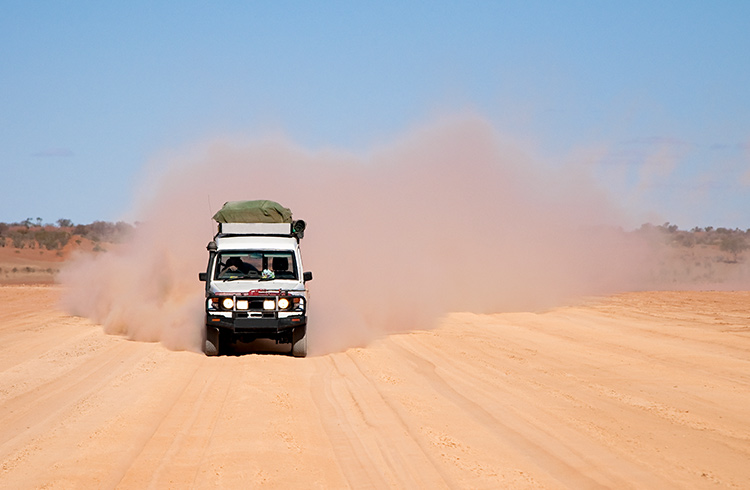How to Road Trip the Rugged Australian Outback Safely
Excited to undertake a road trip into Australia's remote Outback? Before you start planning the journey, find out about the dangers so you can prepare for a safe adventure.
 Photo © Getty Images/georgeclerk
Photo © Getty Images/georgeclerk
Driving around Australia should not be underestimated. There's nothing simple about taking a road trip through the remote, dry, Outback.
- Australia's size will surprise you
- Rules for driving in remote Australia
- Aussie Outback driving tips
- Other survival tips
Australia's size will surprise you
Many visitors are unprepared for the size of Australia. Maps are deceiving, and what looks like a reasonably short drive can be much longer.
Road conditions are equally deceiving. Where you might expect a European-style motorway between major cities, you encounter single-lane dual carriageway (sadly true of large parts of Highway 1).
You might be tempted to pick up a second-hand Kombi and go free-wheeling, which is okay if you're sticking to the more populated regions. But, there's a reason 4WDs are everywhere in the Outback (remote regions) – few sedans can survive the rough terrain and harsh conditions.
Before you even contemplate jumping into your shiny new 4WD and setting off for the Outback, there are quite a few other things you should do first.
Rules for driving in remote Australia
Without a doubt there are two rules which will save your life in remote regions: always let someone know where you are going to and when you expect to arrive and; always stay with your vehicle if you break down. This will save your life.
Also, if you have no experience with a 4WD and are renting one, make sure you know how to engage the four-wheel drive – failure to do so has led to some pretty embarrassing "rescue" stories.
Here's the list of basics to take with you:
- Maps of the area - as detailed and as current as possible
- A compass, matches and fire-lighter blocks
- Water: lots of it, if you are unsure - take more
- Food: enough for each person for two days
- Clothes: two changes of clothes, one for the heat, one for the cold
- Medicine: put together a kit with bandages, band-aids, antiseptic cream, sunblock, a broad-spectrum antibiotic, insect repellent, paracetamols, and anything else you feel you may need - which hopefully you won't need
- Tools: a complete set, especially a jack that works (and know how to work it); if going to the remote Outback, take two jacks and preferably two spare tyres (before you set out, make sure your spare tires are correctly inflated); spare globes, spare fan belt, spare fuses, and at least one big torch and a long-handled shovel.
- Radio: one that can pick up at least one station, to keep across changes in the weather
- For the remote outback, a 2-way HF radio with Flying Doctor and Telstra frequencies is essential. Mobile phone signal coverage is limited at best and generally non-existent, so you may want to think about renting a satellite phone
- A loud whistle.
Aussie Outback driving tips
Tires
Check your tyre pressure each morning before you set off with your own pressure gauge, don't let air out of tyres as heat and pressure increase it. Also, you need to deflate tires when crossing sandhills or tackling sandy tracks.
Fuel
Because you can have fuel pipe problems on rough terrain, take an extra 20-liter metal jerry can or two with you, plus a funnel for filling the tank, especially if you're visiting a remote area. Never carry spare fuel in plastic containers because they can crack, use metal jerry cans and mount the cans on the back of your vehicle or carry them on a trailer. Never carry fuel on roof racks or inside the vehicle.
Road conditions
Try to maintain a straight course rather than dodge every pothole and if the road is corrugated, try to 'ride' the ridges. Driving in sandy areas is hazardous at the best of times, so you should learn how to negotiate sand. Reduce your tyre pressure to 15psi to cope with the soft surface and remember to inflate them immediately once you hit harder ground. Carrying a 12v compressor for this job is a must.
Overtaking is a major hazard in the outback, visibility is often poor and the chances of a stone hitting and smashing your windscreen are very high. On gravel or earth roads, the dust thrown up from vehicles in front makes it almost impossible to see. Wait until the dust has settled and if you are in a dust storm pull over and wait until the storm is over. Road Trains are another major hazard, some are up to 50m long, 2.5m wide and travel around 90km/h, take this into consideration when you attempt to overtake them.
Basics
- Check the conditions of Outback roads before leaving the nearest major town
- Take care when driving 4WD vehicles, eg drive at reduced speeds on unsealed roads
- Note where petrol stations are en route
- Take frequent rest breaks and change drivers regularly
- Obey road closure signs and stick to the main roads
- Make sure you take a break every two hours, don't drive more than 8-10 hours a day and never drive after dark.
Weather
Outback weather conditions are harsh at the best of times. Dust storms, rainstorms and intense heat are fairly standard. Road conditions can change on an almost daily basis. Before you set out for your next destination check the conditions with the locals, the tourist information center, the police, rangers or even at the petrol station.
Other survival tips
If you are stranded for any reason the following may help:
- Rig a lean-to shelter and stay under it during the heat of the day
- Dig a hole under the car and place your water & food in to keep it cool, it will be cooler under there than in your car
- Build a small fire and have some green growth on hand to place on top to create thick smoke, keep it going day and night. This could attract the attention of planes, other vehicles or stockmen in the area
- Ration your food & water - you do not know how long it will have to last
- Use your rear vision mirror to signal passing planes by flashing it into the sun
- Keep your clothes on as they will protect you against exposure - cold and hot.
Finally, don't panic. A ground signal for motorists needing help is simple and the following two codes should be used:
- SOS - means that a motorist has a survival problem
- X - means that the motorist is unable to proceed.
Both signals should be large enough to be identified from a reasonable height and should be formed preferably in white material.
Related articles
Simple and flexible travel insurance
You can buy at home or while traveling, and claim online from anywhere in the world. With 150+ adventure activities covered and 24/7 emergency assistance.
Get a quote


No Comments